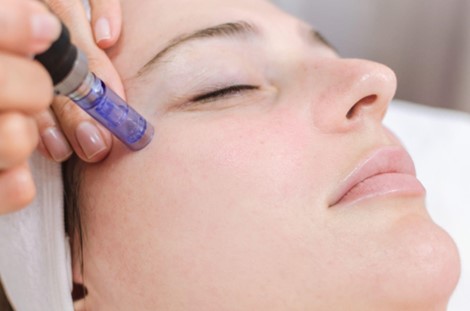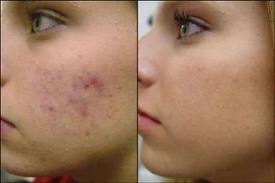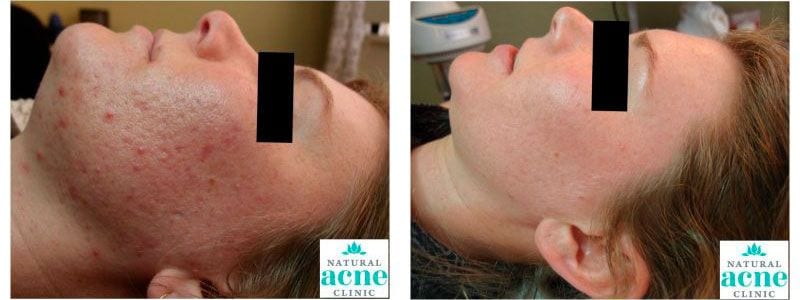Acne scarring can be just as worrisome and stubborn as acne itself. Acne scarring may not affect everyone, but for those with scarring, finding a treatment that works quickly and effectively to reduce its appearance might feel like a never-ending battle.
If you suffer from acne scarring, hope is not lost! Microneedling treatments can be an effective solution to treat acne scars and restore your skin’s complexion. So, how does it work? First, it’s helpful to understand how acne scars are formed.
Acne scarring develops when inflamed pimples damage the skin’s pores. The inflamed pore swells and its structure collapses, damaging deep layers of the skin. Your skin attempts to heal from the trauma of acne by producing scar tissue throughout the layers of damaged skin.
Scar tissue is predominantly made up of new skin tissue and collagen, which is a protein that can help repair and support the skin. Acne scars emerge if the body generates either too little or too much collagen, which can be a complication of severe acne.
Microneedling is a minimally-invasive therapy that is used to help treat acne scars of varying severity and is appropriate for all skin types. It stimulates the body’s natural healing processes to regenerate the damaged skin tissue and produce more collagen. This process works to lift and smooth the skin’s surface to drastically reduce the visibility of acne scars.
In this article, we’ll go over how microneedling works, the different types of microneedling treatments, and some advanced cosmetic therapies available which complement microneedling. More specifically we’ll discuss how DermaPen microneedling offers an effective, efficient therapy to restore your smooth, vibrant skin, making acne scars a thing of the past.
What Is Microneedling?
Firstly, microneedling isn’t quite as intimidating as it sounds. It is also known as collagen induction therapy or fractional microneedling. Microneedling stimulates the skin’s natural healing process and collagen growth, without the use of toxic chemicals or costly lasers.
The treatment is similar to acupuncture; however, it uses different techniques and devices to achieve widespread cosmetic benefits.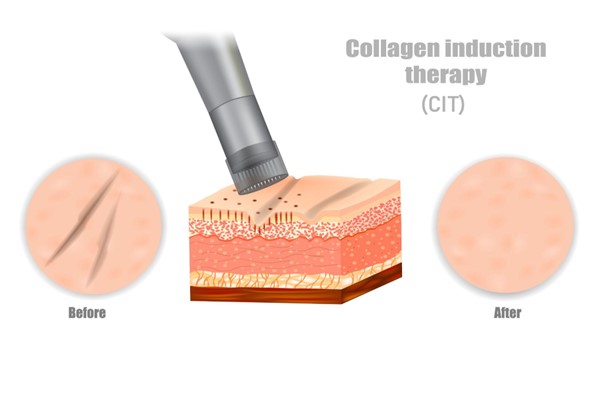
Microneedling involves using multiple fine needles to puncture the skin, which causes trauma to the pores on a microscopic level. As a result of the trauma, the skin begins to repair itself by producing fresh skin tissue, collagen, and other beneficial toning properties like elastin.
When collagen and elastin develop, they elevate and level out the skin, which counteracts the appearance of deep acne scarring and other blemishes. This helps eliminate acne scarring and restores the skin’s smooth, firm appearance. Not only that, but it can also help prevent acne from recurring since it reduces the skin’s ability to produce ‘sebum’, which causes oily skin.
Microneedling is typically less painful and better tolerated than more invasive procedures like laser skin resurfacing or deep chemical peeling. It also offers a short and easy recovery time, few side effects, and other great therapeutic advantages such as reducing pore size and hyperpigmentation (discolored skin spots).
Microneedling can also be used in combination with other skin treatments for more complex acne scarring or other complex skin conditions.
Different Types Of Microneedling Treatment
There are a few different types of microneedling procedures, each with differing benefits for treating various kinds of acne scars. Depending on the severity and characteristics of your specific acne scarring, a therapist might recommend one of the following microneedling treatments.
Traditional Microneedling
Traditional microneedling is done with a hand-held device either through a dermaroller or a spring-loaded Dermapen. These tools make thousands of microscopic punctures, or “microchannels” in the skin. Microneedling stimulates new tissue growth while the tiny microchannels are filled with the healing properties of collagen and elastin.
This process lifts, tightens, and rejuvenates the skin. Over a series of treatments, the skin displays a beautifully rejuvenated look with drastically reduced acne scarring and other blemishes. Additional benefits include fewer wrinkles, more even skin pigmentation, and generally more vibrant skin.
Fractional Radio Frequency Microneedling
Microneedling can also be used in combination with radio frequency (RF) waves. This involves a special microneedling device where the fine needles also emit RF energy. The heat released by the RF waves warms the underlying layers of skin, causing them to tighten.
This, paired with microneedling’s stimulation of collagen and elastin growth, can generate faster results which may require fewer sessions to get the desired benefits. However, the combination of heat and microneedling can make this process more painful and less tolerable.
Microneedling Devices: How Do They Differ?
There are a few key differences to consider when deciding between microneedling treatments, including the devices used to administer the therapy. Microneedling treatments can be performed using either a dermaroller or a Dermapen, both of which promote tissue rejuvenation and collagen formation.
Yet, there are some important differences in how they provide the therapy that should be carefully considered for your specific skin type and degree of acne scarring.
Dermaroller
The dermaroller is a portable device that is normally around the size of a razor. Its rotating drum-shaped head is covered in many tiny needles. There are several different dermarollers available with different needle sizes and lengths to suit your individual needs.
Depending on the degree of acne scarring, longer or wider needles may be used for more severe or different forms of scarring.
The dermaroller is rolled over problematic skin areas with even pressure, allowing the needles to penetrate the pores. Since the dermaroller is a manual tool, unequal or unevenly placed pressure may lead to patchy or uneven results.
The shape of a dermaroller can also make it challenging to apply around the contours of the nose, lips, and eyes. It may also be more painful throughout these sensitive areas.
A Dermaroller’s rolling motion across the skin can also cause the small needles to enter the skin at an angle, which may tear or split the pores. This causes more damage to the skin than necessary, perhaps increasing negative effects or less effective results. Because the roller can “tear” the skin, it is not recommended.
Importantly, because the dermaroller is a reusable device, it is critical to properly prepare both the dermaroller and your skin to avoid the risk of infection.
Dermapen
The DermaPen is also a handheld device which utilizes automated spring-loaded technology. The pen-like design has the advantage of allowing the fine micro-needles to “stamp” the skin vertically, where it can precisely administer columnar-type penetrations into the skin.
This minimizes skin irritation and pore tearing while still encouraging the formation of collagen and elastin. The dermapen has multiple adjustable settings, altering the length at which the needles penetrate the skin. This allows it to be therapy customized to the specific needs of your skin and the degree of acne scarring.
Additionally, infection risks are significantly reduced because the DermaPen uses single-use-only disposable cartridges. Clients who use the DermaPen for microneedling often report less discomfort, quicker recovery, and better results. To learn more and to make an appointment, read our article on Dermapen Microneedling.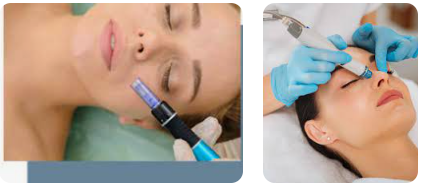
Dermapen For Acne Scars: How Does It Work?
Acne inflammation damages the skin’s natural structure, resulting in scarring as collagen and new tissue try to repair the damage. The scars might appear as indentations or as raised bumps along the skin, and the type of scarring depends on how much collagen your body produces.
The severity of acne, how deeply it penetrates the skin, and how far it spreads will all influence the appearance of scarring. If the acne’s inflammatory fluid spreads to the surrounding skin, scarring can become more severe.
The DermaPen’s single-use cartridges each have 11 very fine microneedles. The spring-loaded technology allows the micro-needles to penetrate the skin as the therapist guides it along the contours of the face and problematic areas.
It also helps the Dermapen to penetrate the skin more accurately, creating precise micro-channels and damaging the skin’s underlying cells while not harming the surrounding tissue.
The DermaPen’s next-generation technology creates a controlled environment for skin healing, allowing for more structured collagen and elastin growth. Restorative growth of collagen, elastin, and new skin cells fills the individual microchannels. This helps the skin return to its natural shape and texture, significantly reducing the appearance of acne scars.
DermaPen microneedling has the best results in indented or depressed (atrophic) acne scarring and can be used on both the face and the body. It can be adjusted to multiple pre-determined depths that will cater to individual needs and different types of acne scarring in one treatment.
Generally, there are three forms of atrophic scarring, and it’s not uncommon to have more than one type. They include:
- Boxcar scars: This indentation scarring has the appearance of a broad, distinct puncture to the skin. The edges are pronounced and travel deep into the skin. Areas with thicker skin, including the lower cheeks, jawline, or back are more prone to boxcar scars.
- Ice-pick scars: This type of acne scarring is shaped like an ice-pick. Having a large indentation at first, it then narrows to a point as it penetrates further into the layers of skin. Ice-pick scars typically occur on the forehead or cheeks because of the delicate, sensitive skin there. Unfortunately, ice-pick scarring is quite common yet particularly difficult to treat due to its shape.
- Rolling scars: These are the depressed scars that appear to slope inwards, creating uneven or bumpy skin. They are also especially noticeable where the skin is thicker, along the jawline, in the lower parts of the cheeks, or across the back and shoulders.
At Natural Skincare & Acne Clinic, we assess both the severity and distinctiveness of your acne scars to ensure that microneedling treatments are appropriate for you. Wherever possible, we prioritize using the
Dermapen for quicker and more effective results, starting you on the journey to blemish-free skin. With its adjustable settings, the dermapen can improve most types of acne scars in a single session, potentially reducing the total number of sessions required.
The benefits of Dermapen microneedling are often seen after just one session, although a treatment every week for 4-6 weeks is recommended for optimal and long-lasting results. Further treatments may be required to get positive results for more complex acne scars, which can be assessed during a complimentary consultation with one of our therapists.
What To Expect During Your Dermapen Microneedling Treatment
Patient comfort and satisfaction are of paramount importance here at Natural Skincare & Acne Clinic. A fast-acting topical anesthetic is applied first to reduce any discomfort.
The skin is then prepared with a cleansing solution. The DermaPen microneedling device is the preferred device at our clinic due to its spring-loaded stamping motion, which eliminates discomfort and provides optimal results for complex skin.
The therapist carefully selects the DermaPen settings after assessing your skin, altering these settings as needed to tailor the therapy to your skin’s specific needs. The Dermapen is then applied across the skin, puncturing it with the applicator. The session can take anywhere from 20 to 30 minutes or longer if the area is larger.
A serum may be applied after the treatment to help speed up the healing process or address any particular skin issues. Finally, a high-SPF sunscreen is used to protect the skin.
What To Expect After Your Dermapen Microneedling Treatment
DermaPen microneedling has a very simple and minimal recovery period, as the skin works fairly quickly to heal. After the treatment, there may be some noticeable skin sensitivity.
Sensitivity happens as a result of the skin’s newly exposed micro-channels, which have limited protection until the skin heals. These should reduce after 24 hours, and completely disappear after 3 days, with some areas potentially being more sensitive than others. Depending on how vigorous the treatment was, you might experience some of these temporary side effects:
Skin Irritation
Skin irritation occurs because the microneedling therapy has delicately injured the skin and is working quickly to mend the microchannels. Your skin may sting or feel a little scratchy, as if it had been recently sunburned.
Pinpoint Bleeding
Pinpoint bleeding occurs when very small spots of blood rise from the microneedling puncture sites. Since there are multiple thin blood vessels under the skin, some of which are closer to the skin than others, it is common to see some bleeding after microneedling. Pinpoint bleeding should subside in 1-2 hours.
Redness
There may be some skin redness visible immediately after microneedling, giving you a similar appearance to having recently finished a tough workout. As a normal part of the healing process, blood rushes to the area and it can leave you looking flushed. Redness usually reduces after a few hours and often disappears the day after treatment.
Skin Flaking
The skin can become dry and flakey after microneedling, particularly around the face. This happens as old skin cells die and new ones replace them as a result of healing, which is what gives your skin a fresh, rejuvenated look. Some mild moisturizers can help hydrate the skin and reduce peeling.
Despite the growing popularity of DIY at-home alternatives to microneedling and dermapen kits, the experts at Natural Skin Clinic strongly advise against them. If microneedling procedures are not done properly or in a sterile way, it can lead to patchy results or some more serious side effects.
For example, if a dermaroller for home use is not properly cleaned or the skin is not carefully prepared, serious skin infections may develop. There is also a risk of worsening acne scarring if the microneedling is done with inappropriate pressures, depths, or techniques.
Hyperpigmentation may also occur as a result of irregular healing, a side effect particularly seen in those with darker skin tones.
Naturally, it’s not ideal to have significant adverse reactions harm your skin, particularly your face, and if it’s possible to avoid it, we certainly should. It is highly recommended that you seek out a certified, experienced therapist for microneedling treatments.
You may also consider asking for a patch test in the beginning, particularly if you have notably sensitive skin or darker pigmentation.
Microneedling Aftercare
The microneedling procedure opens thousands of microchannels in the skin. Depending on the treatment type, these microchannels may take up to 3 days to completely heal. During this time, your skin will be more absorbent, more vulnerable to infection, and especially sensitive to strong creams or serums.
To prevent infection, avoid touching your face after the treatment or engaging in activities that cause you to sweat excessively, such as saunas or intense exercise. Additionally, makeup should not be worn for 24 hours after microneedling, and any previously used makeup brushes or sponges should be avoided.
The raw skin will also be more sensitive to ‘everyday’ facial cleansers, serums, and moisturizers. This is because their ingredients can reach deeper layers of the skin, which might be harmful.
At Natural Skin Care Clinic, a post-treatment product regime will be prescribed for you to use at home. Along with being safe for the skin at this sensitive time, these products also help promote healing and stimulate collagen regrowth.
Best Products To Use After Microneedling
Sun protection is extremely important after microneedling because your skin will be more susceptible to sun damage as it heals. If you are exposed to the sun following a microneedling treatment, you should apply a lightweight, non-toxic sunscreen.
When it comes to protecting the skin and promoting efficient healing after microneedling, we highly recommend the AnteAge Growth Factor Serum as well as a combination of Vitamin A with Epidermal Growth Factor and a Vitamin C serum. These serums bring benefits such as faster results to the acne scarring treatment, enhanced hydration for smoother skin, and a firmer, more vibrant skin tone.
The AnteAge Growth Factor Serum uses advanced stem cell therapy to speed up the healing process across the treated skin. Epidermal Growth Factor provides the building blocks for collagen and elastin production, resulting in near-flawless skin regeneration on a cellular level.
Vitamins A and C are long-standing dermatologist favorites that have been proven to slow skin aging, improve the appearance of acne, and protect the skin from sun damage. It’s important to use high-quality vitamin A and C serums, as some may be suspended in cheaper and more harsh solutions that should not be used after a microneedling treatment.
Achieve Glowing Skin With Minimal Effort
The use of microneedling can significantly improve the appearance of atrophic acne scars and other blemishes. It creates microscopic damage to the skin which stimulates the natural healing response. When new tissue, collagen, and elastin develop as a result of skin healing, it treats acne scarring by restoring overall skin texture and tone while tightening and rejuvenating the skin.
Dermapen microneedling is one of the safest and most easily-tolerated treatments for acne scars when performed by a skilled and certified therapist. Its advanced technology administers more precise treatment to the skin and can be adjusted to suit all skin types and acne scarring severity.
The professionals at Natural Skin Care Clinic can provide comprehensive skin assessments, professional advice, and advanced treatment options for acne scarring and many other skin concerns. We offer a specialized range of treatments for acne scarring, rosacea, anti-aging, uneven texture, and more.
Our team is dedicated to assisting you in taking charge of your inner health and outer beauty, and we customize treatments to the unique needs of your skin. We want to see you reclaim your self-confidence with naturally beautiful skin!
Find out about Dermapen at the Natural Skincare Clinic.

